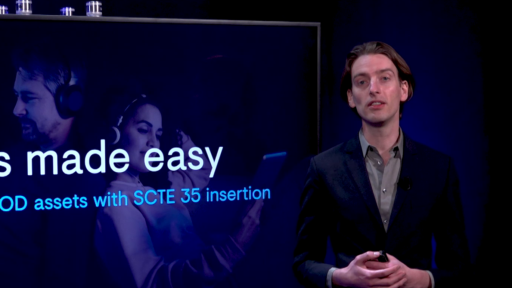Server-side Dynamic Ad Insertion for VOD is hard and expensive, right? You’ll have to re-encode your entire content library, find a way to add the SCTE 35 markers necessary for ad insertion … and you may even need to upgrade your encoders to make it all work. That does not sound enticing. Instead, what if one flexible, lightweight software solution could prepare your content for ad insertion with none of the hassle?
Introducing Unified Remix AVOD, our new solution to make dynamic ad insertion work with any VOD library.
With Remix AVOD there’s no need to re-encode all your content or deal with additional tools for adding SCTE 35 markers. Remix AVOD supports both DASH and HLS, and is compatible with the majority of third-party ad insertion services, like Yospace, AWS Elemental MediaTailor and Ad Insertion Platform (more info).
In this blog post we’ll explain how Remix AVOD works and highlight the two main use cases: ad insertion and ad replacement.
Inserting ads
Over the past decade, subscription fees may have been the main revenue driver for many video streaming services, but it might be time to look beyond them.
Some serious new contenders are entering the arena of video streaming, meaning customers will soon have even more services to choose between, making price a more decisive point of comparison. As the market becomes more competitive by the day, there’s no doubt that the role of advertisements will grow significantly over the next few years.
Take Disney for example, which is getting ready to make a big splash by undercutting market prices with their recently announced bundle that includes the upcoming Disney+, ESPN+ and the ad-supported version of Hulu. Or Netflix’s increase in monthly fees that led a considerable number of subscribers to leave the popular service. There’s also new research showing that subscribers are okay with being served ads as long as it gets them a discount.
Needless to say, advertisements are familiar territory within the world of media. They offer a tried and tested way to monetize content, and one that audiences are familiar with. Many video streaming services may be built on subscription fees, but several successful ones out there have run free-to-view ad-supported platforms for some time. In Europe, for example, there are the likes of Channel 4’s All 4, Viacom’s PlutoTV and some offerings from the multinational RTL Group. For platforms such as these, Remix AVOD has some game-changing tricks up its sleeve.
Replacing ads
The issue of relevance has a two-fold importance when it comes to ads for VOD. For one, ads get stale. In most cases, there is a window of a few days within which the advertiser will pay a premium price per view. Second, and most obviously, the same ad may not be as relevant to everyone: an ad may be an absolute winner for one region but completely irrelevant to another.
Remix AVOD addresses these issues with its dynamic ad insertion workflow, which allows ad insertion services to run different ads for different regions. And in the case of a Live-to-VOD workflow, Remix AVOD can be configured to start replacing ads only when the original ones are starting to become stale.
That’s right, Remix AVOD can be added to your existing Live-to-VOD workflow. And in case that workflow makes use of Remix nPVR (check the demo), adding AVOD to the mix will be a breeze since both make use of the exact same tool to prepare the content.
Solving core problems
One problem with conventional ad insertion for VOD is that the content may not be properly prepared for ad insertion: it can lack the required SCTE 35 timed metadata to signal the points where ads may be inserted by third-party services, or it may lack the necessary keyframes at such points. Remix AVOD can add both to make your content compatible, enabling ad insertion for all possible scenarios:
- content is not prepared at all, with both SCTE 35 markers and keyframes absent at splice points;
- content is partially prepared, with either SCTE 35 markers or keyframes absent at splice points;
- content is fully prepared, with both SCTE 35 markers and keyframes already present at splice points.
Another problem solved by Remix AVOD is the complexity of implementing a complete ad insertion workflow. Remix AVOD fits ad insertion into existing workflows seamlessly, as it works in tandem with Unified Origin for the dynamic delivery of content, or with Unified Packager where static delivery is preferred (more info).
Remix magic
When Remix AVOD is instructed to add SCTE 35 markers, it will do so in a separate track for timed metadata. Origin or Packager then packages this metadata track together with the media’s other tracks, before translating the timed metadata into signaling for DASH or HLS client manifests.
Remix AVOD’s functionality to insert keyframes is especially useful. These keyframes contain all the information for a player to start playback at the given point in the stream, which is necessary when an ad might be inserted there.
Traditionally, adding a keyframe would require a complete re-encode of the content. However, Remix AVOD will only transcode the particular video segment where the keyframe needs to be inserted. This efficiency offers the flexibility to accomplish the task dynamically if required.
To get started with Remix AVOD, all you need is a SMIL playlist defining the content you want to stream. If necessary, you can also specify the points in the stream where the metadata and keyframes need to be added.
Remix AVOD is then used to generate a Remix MP4 from this playlist, after which Origin or Packager can generate a stream from the Remix MP4, depending on whether you choose to deliver your content in a dynamic or static way.

Dynamic or static?
In a static workflow, you prepare all the content beforehand and put it on a server or CDN for streaming. This is straightforward, but it means that you’ll have to store individual representations of your stream for each playout format. In a dynamic workflow you simply store your source content once and rely on Origin to generate all playout formats for you, based on incoming requests from client devices.
In a dynamic workflow using Origin, you can implement Remix AVOD in two ways. You can either process all of your source content beforehand and store the resulting Remix MP4’s as static files on disk. Or you can choose to also make Remix part of your workflow dynamic. The latter would mean that the SMIL playlist used as input for Remix is only generated when a client device makes a request for playback.
Using Remix dynamically increases its flexibility, albeit at the cost of making it more complex to implement. The advantage to running it dynamically is that you don’t have to specify the exact content of the stream until the moment of playout. This way you can make the stream more relevant, based on customer preferences or other information.
Although a completely dynamic approach can be very powerful, our recommendation is to keep the Remix part of the workflow static in most use cases for Remix AVOD, due to the fact that ads will almost always need to be inserted at the exact same point in the stream. This has proven to be the preferred approach of our customers currently deploying Remix AVOD.
Try it yourself
Exciting times are ahead of us in the video streaming industry. Depending on the market you’re operating in, the landscape of services available to your target audience may change considerably over the next year or so.
With Remix AVOD you can keep your competitive edge in such a volatile market by exploring a hybrid business model that combines ads with subscription fees, or even one that relies on ads only. At the same time, Remix AVOD can help you to keep your ads as relevant as possible.
Remix AVOD will be released as part of our next General Release. In the meantime, please test our demo to see it working for yourself. If you’d like to test out the functionality as part of a closed beta, don’t hesitate to contact us. Likewise, if you have any general questions or would like to talk about a possible implementation, feel free to drop us a line.
More info
- For more information on manifest manipulation-based dynamic ad insertion, please read our blog post on this topic for Live streaming.
- Want to learn more about the advantages of dynamic packaging? We’ve got a blog post on that, too.


